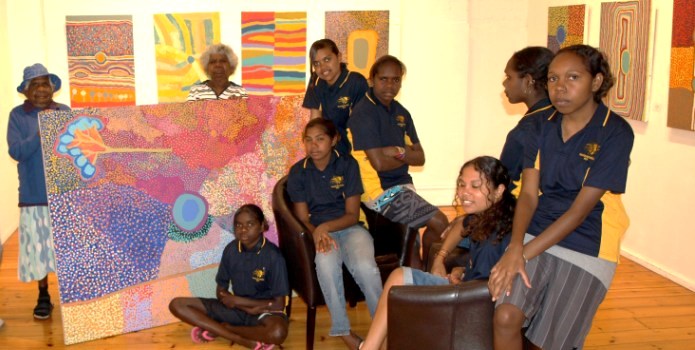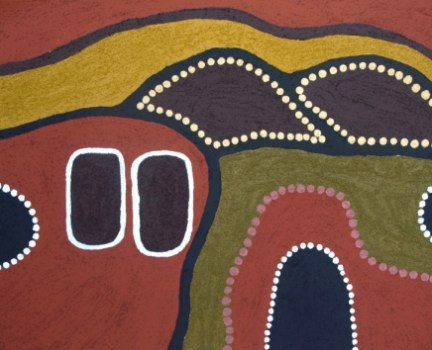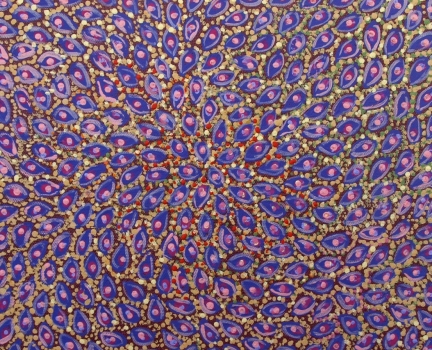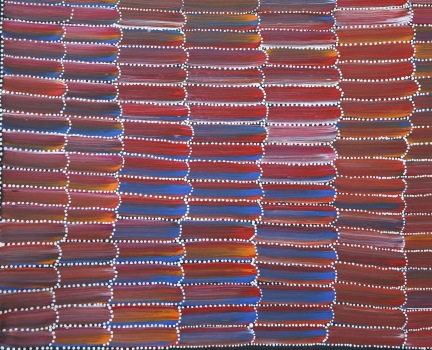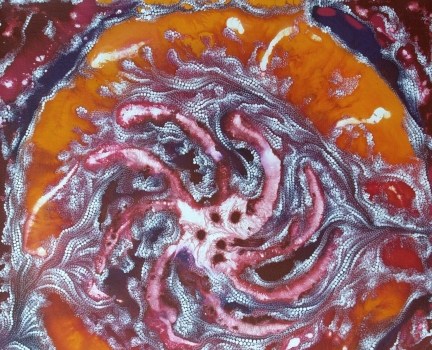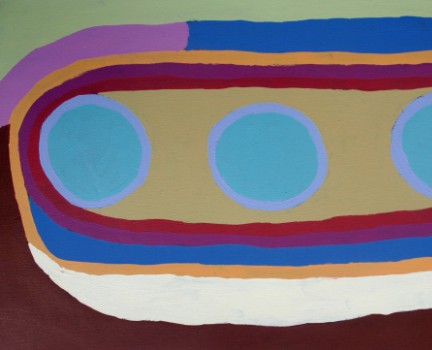Collector Stories – Julie Fowell & Tony Brenton
In this discussion, art collectors Julie Fowell and Tony Brenton talk with Jody Fitzhardinge from Japingka Gallery.
Q: When did you first get interested in art?
Julie: I was teaching in UWA and I met a student who was the daughter of local art dealers. They were also collectors and gallery owners. Her experience growing up as a kid included being taken out to remote areas. She was brought up playing with Aboriginal kids and learning how to do the painting with them. The way she talked about it made me think wow, that's really interesting. I didn't know that was going on.
I had been overseas for 16 years and when I came back to Australia, my cousin took me to a few art galleries where they had special bush paintings from Central Australia. I'd never really seen anything like them before. Having been overseas for so long and being involved in contemporary art, they had a big impact on me. I was blown away by how contemporary and how mystical they were. One gallery event played Aboriginal music and the women danced. I was completely entranced.
Q: Aboriginal people was so invisible in arts back then and the culture was just invisible.
Julie: Yes now there's a lot of more awareness here and overseas. I guess my take on it is that I think they’re probably the best free-form contemporary artists in the world. Both in terms of the way they view things in the world and then how they interpret that. It's something that our Western artists just don't do. We just don't paint that way.
Q: What is your approach to choosing a piece of art to buy?
Julie: We go and have a look in the exhibitions and there is just the piece that you keep going back to. You keep thinking, "I really like that piece," , "Shall I or shan't I?" and then you just go, "Yeah okay,". Then it feels like a celebration because you've purchased something and you know that you're doing some good because you're giving an artist a chance to do more art.
I think there is a bit of a mystification about it. People think you have to be some big corporate dude or own a giant house and lots of spare cash to be able to afford to buy art. I think you just have to say, "Well I'm going to choose this and I'm not going to do that. I'm not going to buy that expensive handbag for example. I suppose my values might be a bit different from other peoples in that regard. I don't need a fancy handbag but I really do need that painting on my wall”.
Q: Tony where was the start point for you?
Tony: It actually was here in Australia, I saw images on the TV. But it was here at Japingka that I actually became familiar and learned to appreciate this type of art. The images on TV never truly do justice to the real thing. You see the paintings for real and they’re so good.
Julie: No matter how good a print is when you put it on a wall it's never going to feel the same because of the matteness of the paint or the texture or the layering you get.
Q: Do you remember the first painting you bought?
Julie: Allery Sandy and it was the bush medicine paintings. We've got four of those but we bought them a pair at a time. They form a cluster in our house. Now we've got quite a few others. I can't always remember the names of them. I've got them written down. There’s work by Gabriella Possum, Rosella Namok and some others.
Q: What's the feeling that they generate for you in your home?
Tony: It's warmth. It feels like they belong because they're Australian. They're warm paintings. We feel buying this art, supporting artists is a small way of paying back. These artists and their communities are so disadvantaged.
I also love that there's so much work in these paintings. These artists aren't just simply putting dots to canvas as there is a rhyme and reason and rhythm in the way they do it.
Q: What paintings or artist do you like best at the moment?
Julie: There was Pansy Sambo with his bush plants and gum leaves. We've got June Peters, The Pannikan Hills. That's a really ochrey one I think.
Tony: Of Purnululu.
Julie: We're interested in Allery Sandy - the mulla mulla plant, some of the little paintings. They're actually quite complex because they show the plant seed and then the flower but then you see these amazing patterns so it becomes an abstract artwork. There is still something in there that you will can see, "Oh there's a plant. It can be the gum leaf you see but the way it's painted is so complex in some, I would say, sophisticated because of the way they have transformed that into an abstract image.
Tony: Repetition in rhythm.
Julie: Yeah repetition in rhythm and I've got Gabriella Possum, the Grandfather Country one. That's the one with the red splashes in it. I keep going back. I find some really bright red splashes in it and there's dots coming out. Spiralling out, but that's a lovely warm painting. That's a kitchen painting. It's warm and it makes me feel vibrant when I'm going to cook. It's so lovely.
Q: I think people don’t think of putting paintings in their kitchen for some reason.
Julie: They don't get dirty. Even if they did it’s ok. The paintings themselves are not pristine. They sometimes come with bits and pieces of seed and a few hairs. Nothing is pristine or perfect in the indigenous art world. It doesn’t need to be - that’s really a Western construct.
Q: Julie you teach design, don't you?
Julie: I do, yes.
Q: As a designer do you get surprised by the compositions?
Julie: I do. I think that the complexity of the compositions and then sometimes the absolute minimalism of them is fantastic. The fashion of design is often trending towards this minimalism and when people think of Aboriginal art they think it's all dots and stripes, but not necessarily. When you look around here there are some very minimalist types of designs in a way and they look very consciously done to some degree but on another point they do look very free. It's like organic design. It's not rigid and it still has rules but you can always go out of the rules a bit.
You've got asymmetry and symmetry and then you've got the randomness and then there's dynamism and then you've got the balance. There's all those things we use when we design a piece of furniture or an interior or an architectural edifice building or what have you. And all those things but it's done in a different way to what we would normally see.
Q: If you met somebody that was really just thinking about this area what advice would you pass on them from the experience of your journey as collectors?
Julie: I think that you don't realise how much joy you get from it and how much warmth it can bring into your home and the lovely memories. I think to myself "Oh yeah I remember we went to that place and we got that one and there was all those other people looking at that one painting and we got it," and then you remember the whole series. It's a little bit of a memory trigger as well but it just gives you a lot of joy having them in the house.
.
The one we got recently was Rosella Namok which is quite largish. We'd sit in the dining room and look across to the lounge room in different times of day and the light hits it, I find myself thinking, "Oh it's so beautiful. I didn't see it in that light before. Did you ever notice that part over there with those splits coming down like this." You can keep discovering things in the paintings. They're fascinating to have in the house because you can keep going back to study them.
I find it interesting that some of the imagery appears to be from high up in the air. There is no explanation for that really. Some of this art comes from places where there is no mountain so you can’t get up high. I’m fascinated by the perspective in some of these paintings.
Q: Is there anything else that you would like to share with a collector just starting their journey?
Julie: Yes I'd say to them - it's really worth it. At the end of the day you don't need that handbag. You really need that painting on the wall because you will have it forever. A handbag will wear out, and you'll never get tired of the paintings. You can hand it down to your kids. This means future generations will have an understanding of Aboriginal things and the richness of their culture.
This art is so accessible. They're not that expensive and they're pleasurable to have around you. It's like having a family in your home. You're also supporting someone that needs to be supported and that feels an important thing to do.
Collecting this art is a a way of bridging the gap between our two cultures. It's a cultural exchange. For us buying the art and looking at the art, understanding the art and then seeing where it can go in terms of contemporary Aboriginal art, that's a cultural exchange. They are our First Nation people and we need to learn stuff from them because they know a lot more about this place than we do. We just chop the trees down and dig stuff up from the ground. The preservation of their culture is really important. Whether it goes from the contemporary or stays in this traditional methodology it's really valuable.

